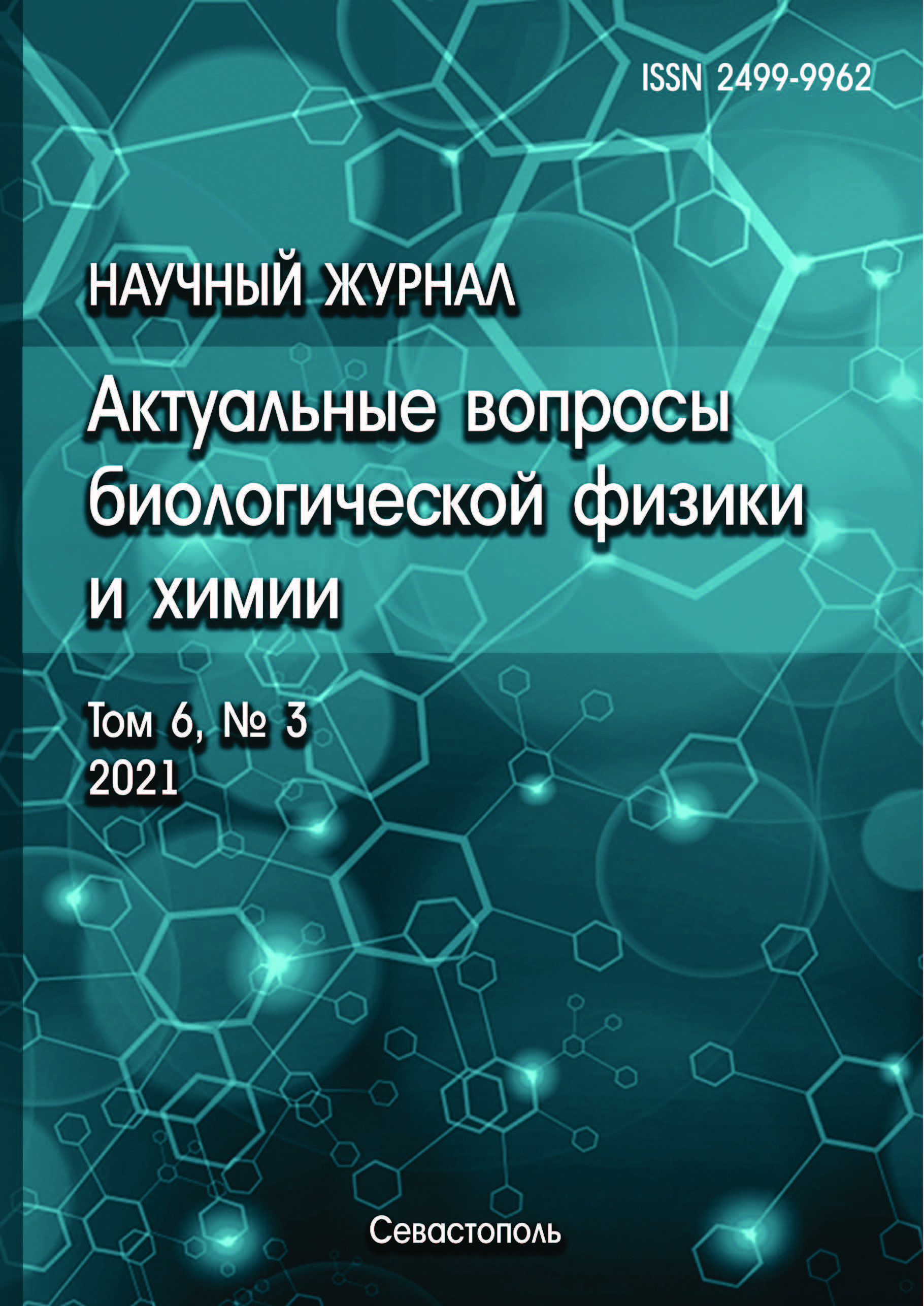Moscow, Moscow, Russian Federation
In this study we first took an integrated approach to the interaction of NO and H2S gases, produced by the bacterial cells within their signaling potencies in DNA repair responses to oxidative damages and control of bacterial biofilm production. In the study of crystalline nitrosyl iron complexes, it was found that combined treatment with an NO donor and hydrogen sulfide, under the condition of a 2.5-fold excess of H2S for each NO-donor group, stimulates an increase in NO-signaling activity due to the formation of more active DNICs with persulfide ligands in the cell, which, in contrast to DNIC with thiol ligands, give a characteristic “narrow” EPR signal with gaver = 2.03 (g⊥ = 2.032, g || = 2.02). Thereby, H2S acts as a mediator of NO signaling activity, thereby stimulating a significant increase in the level of soxS gene expression. The effect of the combined treatment on the level of sfiA gene expression was not found. This phenomenon causes a decrease in the level of oxidative stress during joint treatment with a NO donor and H2S, which has a significant effect on a decrease in the productivity of biofilm formation (on average by 30% relative to mono-treatment) and an increase in the dispersion indicators of mature biofilms (on average by 25% relative to mono-treatment). We suppose that our findings with the complex NO-donors with H2S application may be useful in solving the bacterial biofilm problems.
nitric oxide, hydrogen sulfide, biofilm, signaling functions
1. Davies D. Understanding biofilm resistance to antibacterial agents. Nat. Rev. Drug Discov, 2003, vol. 2, no. 2, pp. 114-122. doi:https://doi.org/10.1038/nrd1008
2. Macia M., Del Pozo J., Diez-Aguilar M., Guinea J. Microbiological diagnosis of biofilm-related infections. Diagnóstico microbiológico de las infecciones relacionadas con la formación de biopelículas. Enferm Infecc Microbiol Clin (Engl Ed), 2018, vol. 36, no. 6, pp. 375-381. doi:https://doi.org/10.1186/s12951-016-0246-1
3. Barraud N., Schleheck D., Klebensberger J., Webb J., Hassett D., Rice S., Kjelleberg S. Nitric oxide signaling in Pseudomonas aeruginosa biofilms mediates phosphodiesterase activity, decreased cyclic di-GMP levels, and enhanced dispersal. J Bacteriol, 2009, vol. 191, no. 23, pp. 7333-7342. doi:https://doi.org/10.1128/JB.00975-09 EDN: https://elibrary.ru/MZYEKT
4. Ding H., Demple B. Direct nitric oxide signal transduction via nitrosylation of iron-sulfur centers in the SoxR transcription activator. Proc. Natl. Acad. Sci, 2000, vol. 97, no. 10, pp. 5146-5150.
5. Lee S.J., Kim D.G., Lee K.Y., Koo J.S., Lee B.J. Regulatory mechanisms of thiol-based redox sensors: lessons learned from structural studies on prokaryotic redox sensors. Arch Pharm Res., 2018, vol. 41, no. 6, pp. 583-593. doihttps://doi.org/10.1007/s12272-018-1036-0 EDN: https://elibrary.ru/HMZSHX
6. Lobysheva I.I., Stupakova M.V., Mikoyan V.D., Vasilieva S.V., Vanin A.F. Induction of the SOS DNA repair response in Escherichia coli by nitric oxide donating agents: dinitrosyl iron complexes with thiol-containing ligands and S-nitrosothiols. FEBS Lett, 1999, vol. 454, no. 3, pp. 177-180. doihttps://doi.org/10.1016/s0014-5793(99)00777-2 EDN: https://elibrary.ru/LFNYMJ
7. Vasilieva S.V., Stupakova M.V., Lobysheva I.I., Mikoyan V.D., Vanin A.F. Activation of the Escherichia coli SoxRS-regulon by nitric oxide and its physiological donors. Biochemistry (Mosc), 2001, vol. 66, no. 9, pp. 984-988. doihttps://doi.org/10.1023/a:1012317508971 EDN: https://elibrary.ru/LGYICN
8. Kim S.K., Lee J.H. Biofilm dispersion in Pseudomonas aeruginosa. J Microbiol, 2016, vol. 54, no. 2, pp. 71-85. doihttps://doi.org/10.1007/s12275-016-5528-7 EDN: https://elibrary.ru/AHKJGS
9. Emeliyanova N.S., Shmatko N.Yu., Sanina N.A. Experimental and quantum-chemical simulation of pH-medium effects on the NO-donor activity of mononuclear nitrosyl iron complex [Fe(SC(NH2)2)2(NO)2]-l · H2O. Izv. Akad. Nauk. Ser. Khim., 2015, no. 10, pp. 2344-2350.
10. Aldoshin S.M., Sanina N.A., Davydov M.I. A new class of nitric oxide donors. Her.Russ. Acad. Sci., 2016, vol. 86, pp. 158-163. doi:https://doi.org/10.1134/S1019331616030096 EDN: https://elibrary.ru/WTGOIP
11. Tinajero-Trejo M., Jesse H., Poole R. Gasotransmitters, poisons, and antimicrobials: it's a gas, gas, gas! F1000Prime Rep., 2013, vol. 5, no. 28. doihttps://doi.org/10.12703/P5-28 EDN: https://elibrary.ru/RIXVMX
12. Scammahorn J.J., Nguyen I., Bos E.M., Van Goor H., Joles J.A. Fighting Oxidative Stress with Sulfur: Hydrogen Sulfide in the Renal and Cardiovascular Systems. Antioxidants (Basel), 2021, vol. 10, no. 3. doi:https://doi.org/10.3390/antiox10030373
13. Lloyd D. Hydrogen sulfide: clandestine microbial messenger? Trends Microbiol., 2006, vol. 14, no. 10, pp. 456-462.
14. Miller J. Experiments in Molecular Genetics. Cold Spring Harb. Lab. Press., 1972.
15. Vasil'eva C.V., Strel'cova D.A., Starostina I.A., Sanina N.A. Oksid azota uchastvuet v regulyacii sborki Fe-S-klasterov belkov i formirovanii bioplenok kletkami Escherichia coli. Izvestiya Rossiyskoy akademii nauk. Seriya biologicheskaya. Akademicheskaya nauka, 2013, № 4, s. 398-404. @@Vasilyeva S.V., Streltsova D.A., Starostina I.A., Sanina N.A. Nitric oxide participates in the regulation of the assembly of Fe-S-clusters of proteins and the formation of biofilms by Escherichia coli cells. Izvestiya Rossiiskoi Akademii Nauk. Seriya biologicheskaya, 2013, vol. 4, pp. 398-404. (In Russ.)
16. Vanin A.F. et al. EPR Characterization of mononuclear dinitrosyl iron complex with persulfide as a new representative of dinitrosyl iron complexes in biological systems: An Overview. Appl. Magn. Reson., 2014, vol. 45, no. 4, pp. 375-387. DOI: https://doi.org/10.1007/s00723-014-0523-9; EDN: https://elibrary.ru/QOTQVZ
17. Vanin A.F. Nitric Oxide Dinitrosyl iron complexes with thiol-containing ligands as a “working form” of endogenous nitric oxide. Nitric Oxide, 2016, vol. 54, pp. 15-29. doi:https://doi.org/10.1016/j.niox.2016.01.006 EDN: https://elibrary.ru/WWALVD
18. Whiteman M., Li L., Kostetski I., Chu S.H., Siau J.L., Bhatia M., Moore P.K. Evidence for the formation of a novel nitrosothiol from the gaseous mediators nitric oxide and hydrogen sulphide. Biochem. Biophys. Res.Commun., 2006, vol. 343, no. 1, pp. 303-310. doi:https://doi.org/10.1016/j.bbrc.2006.02.154
19. Dillon K.M., Carrazzone R.J., Matson J.B., Kashfi K. The evolving landscape for cellular nitric oxide and hydrogen sulfide delivery systems: A new era of customized medications. Biochem Pharmacol., 2020, vol. 176, 113931. doi:https://doi.org/10.1016/j.bcp.2020.113931 EDN: https://elibrary.ru/APOBSM
20. Ozfidan-Konakci C., Yildiztugay E., Elbasan F., Kucukoduk M., Turkan I. Hydrogen sulfide (H2S) and nitric oxide (NO) alleviate cobalt toxicity in wheat (Triticum aestivum L.) by modulating photosynthesis, chloroplastic redox and antioxidant capacity. J. Hazard Mater., 2020, vol. 388, 122061. doi:https://doi.org/10.1016/j.jhazmat.2020
21. Shatalin K., Shatalina E., Mironov A., Nudler E. H2S: a universal defense against antibiotics in bacteria. Science, 2011, vol. 334, no. 6058, pp. 986-990. doi:https://doi.org/10.1126/science.1209855 EDN: https://elibrary.ru/PEFRZX










